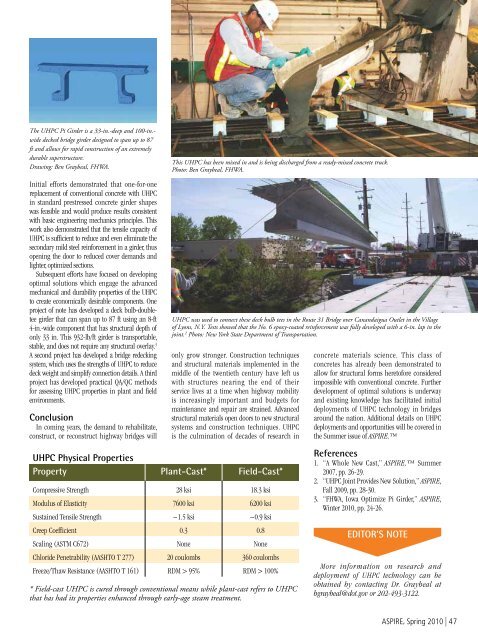ASPIRE Spring 10 - Aspire - The Concrete Bridge Magazine
ASPIRE Spring 10 - Aspire - The Concrete Bridge Magazine
ASPIRE Spring 10 - Aspire - The Concrete Bridge Magazine
Create successful ePaper yourself
Turn your PDF publications into a flip-book with our unique Google optimized e-Paper software.
<strong>The</strong> UHPC Pi Girder is a 33-in.-deep and <strong>10</strong>0-in.-<br />
wide decked bridge girder designed to span up to 87<br />
ft and allows for rapid construction of an extremely<br />
durable superstructure.<br />
Drawing: Ben Graybeal, FHWA.<br />
Initial efforts demonstrated that one-for-one<br />
replacement of conventional concrete with UHPC<br />
in standard prestressed concrete girder shapes<br />
was feasible and would produce results consistent<br />
with basic engineering mechanics principles. This<br />
work also demonstrated that the tensile capacity of<br />
UHPC is sufficient to reduce and even eliminate the<br />
secondary mild steel reinforcement in a girder, thus<br />
opening the door to reduced cover demands and<br />
lighter, optimized sections.<br />
Subsequent efforts have focused on developing<br />
optimal solutions which engage the advanced<br />
mechanical and durability properties of the UHPC<br />
to create economically desirable components. One<br />
project of note has developed a deck bulb-doubletee<br />
girder that can span up to 87 ft using an 8-ft<br />
4-in.-wide component that has structural depth of<br />
only 33 in. This 932-lb/ft girder is transportable,<br />
stable, and does not require any structural overlay. 3<br />
A second project has developed a bridge redecking<br />
system, which uses the strengths of UHPC to reduce<br />
deck weight and simplify connection details. A third<br />
project has developed practical QA/QC methods<br />
for assessing UHPC properties in plant and field<br />
environments.<br />
Conclusion<br />
In coming years, the demand to rehabilitate,<br />
construct, or reconstruct highway bridges will<br />
This UHPC has been mixed in and is being discharged from a ready-mixed concrete truck.<br />
Photo: Ben Graybeal, FHWA.<br />
UHPC was used to connect these deck bulb tees in the Route 31 <strong>Bridge</strong> over Canandaigua Outlet in the Village<br />
of Lyons, N.Y. Tests showed that the No. 6 epoxy-coated reinforcement was fully developed with a 6-in. lap in the<br />
joint. 2 Photo: New York State Department of Transportation.<br />
only grow stronger. Construction techniques<br />
and structural materials implemented in the<br />
middle of the twentieth century have left us<br />
with structures nearing the end of their<br />
service lives at a time when highway mobility<br />
is increasingly important and budgets for<br />
maintenance and repair are strained. Advanced<br />
structural materials open doors to new structural<br />
systems and construction techniques. UHPC<br />
is the culmination of decades of research in<br />
concrete materials science. This class of<br />
concretes has already been demonstrated to<br />
allow for structural forms heretofore considered<br />
impossible with conventional concrete. Further<br />
development of optimal solutions is underway<br />
and existing knowledge has facilitated initial<br />
deployments of UHPC technology in bridges<br />
around the nation. Additional details on UHPC<br />
deployments and opportunities will be covered in<br />
the Summer issue of <strong>ASPIRE</strong>.<br />
UHPC Physical Properties<br />
Property Plant-Cast* Field-Cast*<br />
Compressive Strength 28 ksi 18.3 ksi<br />
Modulus of Elasticity 7600 ksi 6200 ksi<br />
Sustained Tensile Strength ~1.5 ksi ~0.9 ksi<br />
Creep Coefficient 0.3 0.8<br />
Scaling (ASTM C672) None None<br />
Chloride Penetrability (AASHTO T 277) 20 coulombs 360 coulombs<br />
Freeze/Thaw Resistance (AASHTO T 161) RDM > 95% RDM > <strong>10</strong>0%<br />
* Field-cast UHPC is cured through conventional means while plant-cast refers to UHPC<br />
that has had its properties enhanced through early-age steam treatment.<br />
References<br />
1. “A Whole New Cast,” <strong>ASPIRE</strong>, Summer<br />
2007, pp. 26-29.<br />
2. “UHPC Joint Provides New Solution,” <strong>ASPIRE</strong>,<br />
Fall 2009, pp. 28-30.<br />
3. “FHWA, Iowa Optimize Pi Girder,” <strong>ASPIRE</strong>,<br />
Winter 20<strong>10</strong>, pp. 24-26.<br />
Editor’s Note<br />
More information on research and<br />
deployment of UHPC technology can be<br />
obtained by contacting Dr. Graybeal at<br />
bgraybeal@dot.gov or 202-493-3122.<br />
<strong>ASPIRE</strong>, <strong>Spring</strong> 20<strong>10</strong> | 47

















